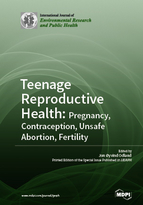Teenage Reproductive Health: Pregnancy, Contraception, Unsafe Abortion, Fertility
A special issue of International Journal of Environmental Research and Public Health (ISSN 1660-4601). This special issue belongs to the section "Global Health".
Deadline for manuscript submissions: closed (1 February 2018) | Viewed by 101415
Special Issue Editor
Interests: public health; epidemiology; environmental health; reproductive health; pregnancy care; climate change
Special Issues, Collections and Topics in MDPI journals
Special Issue Information
Dear Colleagues,
We are organizing a Special Issue on Teenage Reproductive Health in the International Journal of Environmental Research and Public Health. The venue is a peer-reviewed scientific journal that publishes articles and communications in the interdisciplinary area of environmental health sciences and public health. For detailed information on the journal, we refer you to https://www.mdpi.com/journal/ijerph.
Maternal mortality is still globally high and reducing it is a top priority. Teenage pregnancies have more complications and are also unwanted in many cases. This contributes to the high maternal mortality with both obstetric complications and the burden of unsafe abortion. Additionally, many teenagers live in areas with heavy pollution that affect the mother and the unborn child. Global public health is a very important issue that aims to prevent disease, prolong life, and promote physical, mental, and social well-being. Teenagers are the future and maternal death is a disaster that should be prevented. Hence, research should aim to improve teenage reproductive health and influence policy makers.
This Special Issue is open to any subject related to teenage reproductive health and its link to the environment. The listed keywords suggest just a few of the many possibilities.
Prof. Dr. Jon Øyvind Odland
Guest Editor
Manuscript Submission Information
Manuscripts should be submitted online at www.mdpi.com by registering and logging in to this website. Once you are registered, click here to go to the submission form. Manuscripts can be submitted until the deadline. All submissions that pass pre-check are peer-reviewed. Accepted papers will be published continuously in the journal (as soon as accepted) and will be listed together on the special issue website. Research articles, review articles as well as short communications are invited. For planned papers, a title and short abstract (about 100 words) can be sent to the Editorial Office for announcement on this website.
Submitted manuscripts should not have been published previously, nor be under consideration for publication elsewhere (except conference proceedings papers). All manuscripts are thoroughly refereed through a single-blind peer-review process. A guide for authors and other relevant information for submission of manuscripts is available on the Instructions for Authors page. International Journal of Environmental Research and Public Health is an international peer-reviewed open access monthly journal published by MDPI.
Please visit the Instructions for Authors page before submitting a manuscript. The Article Processing Charge (APC) for publication in this open access journal is 2500 CHF (Swiss Francs). Submitted papers should be well formatted and use good English. Authors may use MDPI's English editing service prior to publication or during author revisions.
Keywords
- Teenage pregnancies
- Unwanted pregnancies
- Unsafe abortion
- Postabortion care
- Contraception
- Fertility
- Environmental impacts on pregnancy, pregnancy outcome, and early child development






